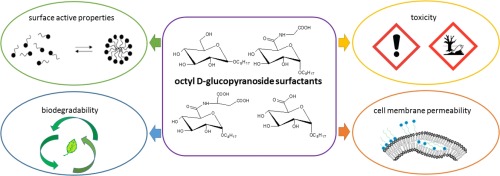Chemosphere ( IF 8.1 ) Pub Date : 2018-11-05 , DOI: 10.1016/j.chemosphere.2018.11.025 Agata Zdarta , Amanda Pacholak , Wojciech Smułek , Agnieszka Zgoła-Grześkowiak , Nadège Ferlin , Abed Bil , José Kovensky , Eric Grand , Ewa Kaczorek

|
Development of many branches of industry has stimulated the search for new, effective surfactants with interesting properties. Potential use of alkyl glucose derivatives on a large scale, raises questions about the possible risks associated with their entry into the natural environment. To be able to evaluate this risk, the aim of the study was to determine the physicochemical properties of octyl D-glucopyranoside and its three derivatives: N-(octyl D-glucopyranosiduronyl)aspartic acid, N-(octyl D-glucopyranosiduronyl)glicyne and octyl D-glucopyranosiduronic acid. Moreover, their biodegradability by pure bacterial strains and biocenosis present in river water was examined. While descriptions of sugar-based surfactants on microbial cells are limited, the essential element of the study was to determine the effect of surfactants on cell surface properties of microorganisms isolated from activated sludge and compare it to the effects of the petroleum based surfactants and the surfactants produced from renewable materials. The results obtained indicate that physicochemical properties of surface active agents differ depending on the presence of functional groups in the surfactants molecules. What is more, the presence of amino acid substituent in the derivatives of octyl D-glucopyranoside resulted in a slight decrease in the surfactants biodegradation efficiency, in comparison to the compounds that did not contain such a substituent, prolonging this process from 5 to 10 days. Interestingly, even relatively slightly different derivatives modified the cell surface properties in a different way. Importantly, the surfactants based on octyl D-glucopyranoside have less negative impact on environmental microorganism and better biodegradability than the surfactant synthesized from petroleum products.
中文翻译:

辛基D-吡喃葡萄糖苷表面活性剂的生物影响
许多行业分支的发展刺激了对具有有趣特性的新型有效表面活性剂的寻求。烷基葡萄糖衍生物的潜在大规模使用引发了有关其进入自然环境的潜在风险的疑问。为了能够评估这种风险,该研究的目的是确定辛基D-吡喃葡萄糖苷及其三种衍生物的理化性质:N-(辛基D-吡喃葡萄糖苷神经酰基)天冬氨酸,N-(辛基D-吡喃葡萄糖苷古龙糖基)格力炔和辛基D-吡喃葡萄糖苷古龙糖醛酸。此外,检查了它们在河水中的纯细菌菌株的生物降解性和生物污染。尽管对糖基表面活性剂对微生物细胞的描述是有限的,但这项研究的基本要素是确定表面活性剂对从活性污泥中分离出的微生物的细胞表面特性的影响,并将其与石油基表面活性剂和表面活性剂的影响进行比较。由可再生材料制成。获得的结果表明,表面活性剂的物理化学性质取决于表面活性剂分子中官能团的存在而不同。更,与不含这种取代基的化合物相比,辛基D-吡喃葡萄糖苷衍生物中氨基酸取代基的存在导致表面活性剂的生物降解效率略有降低,从而使该过程延长了5至10天。有趣的是,即使相对稍微不同的衍生物也以不同的方式修饰细胞表面特性。重要的是,与从石油产品合成的表面活性剂相比,基于辛基D-吡喃葡萄糖苷的表面活性剂对环境微生物的负面影响较小,生物降解性更好。

































 京公网安备 11010802027423号
京公网安备 11010802027423号